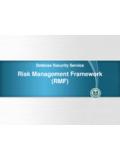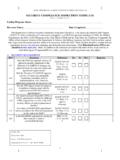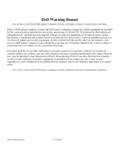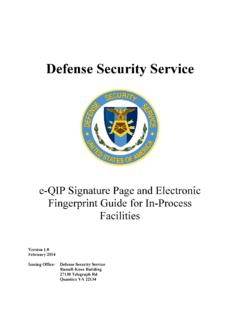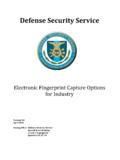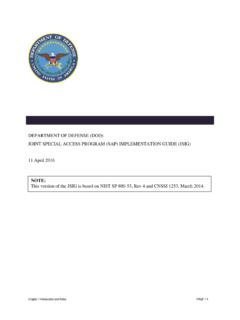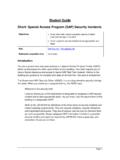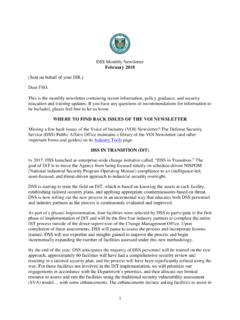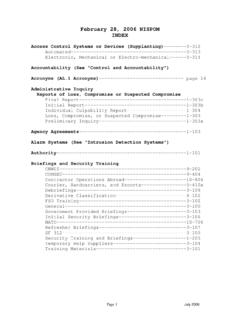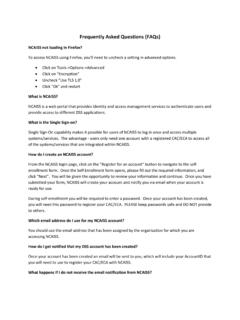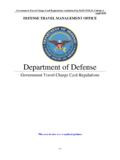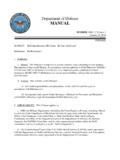Transcription of INDUSTRIAL SECURITY LETTER - Defense Security Service
1 department OF Defense Defense SECURITY Service 27130 Telegraph Road, Quantico, VA 22134 INDUSTRIAL SECURITY LETTER INDUSTRIAL SECURITY Letters (ISLs) are issued peri odically to inform cleare d contra ctors, government contracting activities and DoD activities of developments re lating to industri al SECURITY . These letters are for informati on and clari fication of existing policy and re quire ments. Suggestions for ISLs are appre ciated and should be submitted to the local Defe nse Securit y Service INDUSTRIAL SECURITY Field Office. Please address specific inquiri es about this ISL to DSS. ISL 2016-02 May 21, 2016 (Revised June 29, 2017) On May 18, 2016, the department of Defense published Change 2 to DoD , National INDUSTRIAL SECURITY Manual Operating Manual (NISPOM).
2 NISPOM Change 2 requires c ontractors1 to establish and maintain an insider threat program to detect, deter and mitigate insider threats. Specifically, the program must gather, integrate, and report relevant and credible information covered by any of the 13 personnel SECURITY adjudicative guidelines2 that is indicative of a potential or actual insider threat to deter cleared employees3 from becoming insider threats; detect insiders4 who pose a risk to classified information; and mitigate the risk of an insider Contractors must have a written program plan in place to begin implementing insider threat requirements of Change 2 no later than November 30, 2016. This INDUSTRIAL SECURITY LETTER (ISL) provides clarification and guidance to assist contractors as they establish and tailor an insider threat program to meet NISPOM Change 2 requirements. Nothing in this ISL alters or supersedes the text of the published NISPOM Change 2.
3 Insider Threat Minimum Standards for Contractors NISPOM 1-202 requires the contractor to establish and maintain an insider threat program that will gather, integrate, and report relevant and available information indicative of a potential or actual insider threat. DSS will consider the size and complexity of the cleared facility in assessing its implementation of an insider threat program to comply with NISPOM Change 2. 1 Contractor refers to any INDUSTRIAL , educational, commercial, or other entity that has been granted a facility SECURITY clearance (FCL) by a Cognizant SECURITY Agency (CSA). (NISPOM Appendix C) 2 3 All contractor employees granted personnel SECURITY clearances (PCLs) and all employees being processed for PCLs as defined by the NISPOM. (NISPOM Appendix C) 4 Cleared contractor personnel with authorized access to any Government or contractor resource, including personnel, facilities, information, equipment, networks, and systems.
4 (NISPOM Appendix C) 5 Insider threat is defined as the likelihood, risk, or potential that an insider will use his or her authorized access, wittingly or unwittingly, to do harm to the national SECURITY of the United States. Insider threats may include harm to contractor or program information, to the extent that the information impacts the contractor or agency s obligations to protect classified national SECURITY information. (NISPOM Appendix C) 2 Contractor programs must include the following elements: 1- 202a. An insider threat program plan endorsed by the insider threat program senior official (ITPSO) describing: o Capability to gather relevant insider threat information across the contractor facility ( , human resources, SECURITY , information assurance, legal), commensurate with the organization s size and operations. o Procedures to access, share, compile, identify, collaborate among the cleared contractor s functional elements (including those listed above), and report relevant information covered by the 13 personnel SECURITY adjudicative guidelines that may be indicative of a potential or actual insider threat; to deter cleared employees from becoming insider threats; detect insiders who pose a risk to classified information; and mitigate the risk of an insider threat.
5 O Any corporate-wide program plans that address requirements for all cleared facilities within the corporate family and address effective implementation at each cleared entity within the business structure. Contractors will self-certify to DSS that a written program plan is implemented and current. 1- 202b. Formal appointment by the contractor of an ITPSO who is a citizen employee and a senior official of the company: o The ITPSO will be cleared in connection with the FCL and is responsible for establishing and executing the contractor s insider threat program. o The ITPSO must serve in a position within the organization that has the authority to provide management, accountability, and oversight to effectively implement and manage the requirements of the NISPOM related to insider threat. o The facility SECURITY officer (FSO) may also serve as the ITPSO.
6 If the ITPSO is not the FSO, the contractor s ITPSO will ensure the FSO is an integral member of the contractor s implementation program for an insider threat program. o Contractors will appoint the ITPSO as one of the company s key management personnel in the Electronic Facility Clearance System (e-FCL) at or as directed by the CSA. Additional information is available at 1- 202c. Appointment of an ITPSO for the corporate family: o A corporate family may choose to establish a corporate-wide insider threat program with one senior official appointed to establish and execute the program. 3 o Each cleared legal entity in the corporate family using the corporate-wide ITPSO must separately appoint that person as the ITPSO for that cleared legal entity in e-FCL at o If the corporate family chooses to have the corporate-wide ITPSO also serve as the senior official for cleared divisions or branches within a multiple-facility organization, the ITPSO will provide DSS a list of facilities by Commercial and Government Entity (CAGE) code for which the ITPSO serves as the senior official.
7 DSS, in its discretion, may also require that the ITPSO, if appointed for all the cleared facilities within a multiple-facility organization, be submitted in e-FCL at for each cleared facility. o When a corporate family appoints a single ITPSO, that individual must be able to effectively manage the insider threat requirements for each entity for which they are appointed or maintain a record of the individuals at each cleared facility who are trained in accordance with this ISL to support implementation of insider threat program requirements. 1-207b. Contractor reviews: o A senior management official at the cleared facility will certify annually to DSS in writing that a self-inspection has been completed in accordance with the provisions of NISPOM paragraph 1-207b. o Contractors must make self-inspection reports available to DSS during the next SECURITY vulnerability assessment following the self-inspection.
8 O Additional guidance is in the Self-Inspection Handbook for NISP Contractors at The Self-Inspection Handbook includes guidance on implementing insider threat program requirements. 1- 300. Reporting requirements: o This ISL does not change the reporting requirements of the NISPOM Change 2; it serves to clarify the reporting requirements related to behaviors indicative of insider threat. o Contractors must report relevant and credible information coming to their attention regarding cleared employees. Such reporting includes information indicative of a potential or actual insider threat that is covered by any of the 13 personnel SECURITY adjudicative guidelines , or when that information constitutes adverse information, in accordance with NISPOM 1-302a. (further clarified in ISL 2011-04, Adverse Information ). 4 Training and information on the Federal adjudicative guidelines is available from the DSS Center for Development of SECURITY Excellence (CDSE) at 1- 304.
9 Individual culpability reports: Contractors must have a s ystem or process to identify patterns of negligence or carelessness in handling classified information to ensure reporting in accordance with the requirements outlined NISPOM 1-304c, even for incidents that do not initially warrant a culpability or individual incident report. 3- 103. Insider threat training: o 3- Insider threat personnel assigned duties related to insider threat program management: Training on insider threat program management is required for all personnel assigned duties related to insider threat program management. Contractors must provide internal training for insider threat program personnel that includes, at a minimum, the topics outlined in NISPOM 3-103a. Contractors may use an existing training course to meet the training requirements for insider threat program personnel.
10 CSA-designated training that meets the minimum topics outlined in NISPOM 3-103 is available through the CDSE catalog under Insider Threat at See Establishing an Insider Threat Program for Your Organization, course After initial implementation of NISPOM Change 2, new contractor personnel assigned duties related to insider threat program management must complete the required training within 30 days of being assigned those duties. o 3- Employee awareness: Training on insider threat awareness is required for all cleared employees before being granted access to classified information and annually thereafter. Contractors must provide internal training programs that include, at a minimum, the topics outlined in NISPOM 3-103b. Contractors may use an existing training course to meet the requirements of insider threat awareness training for personnel who access classified information.
